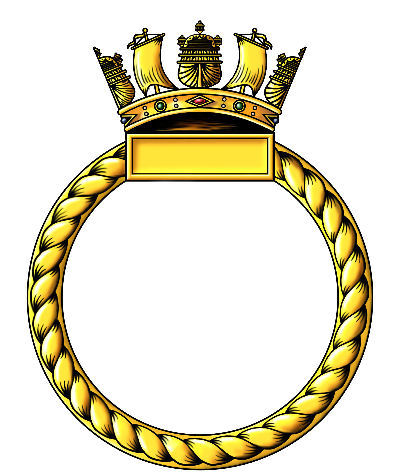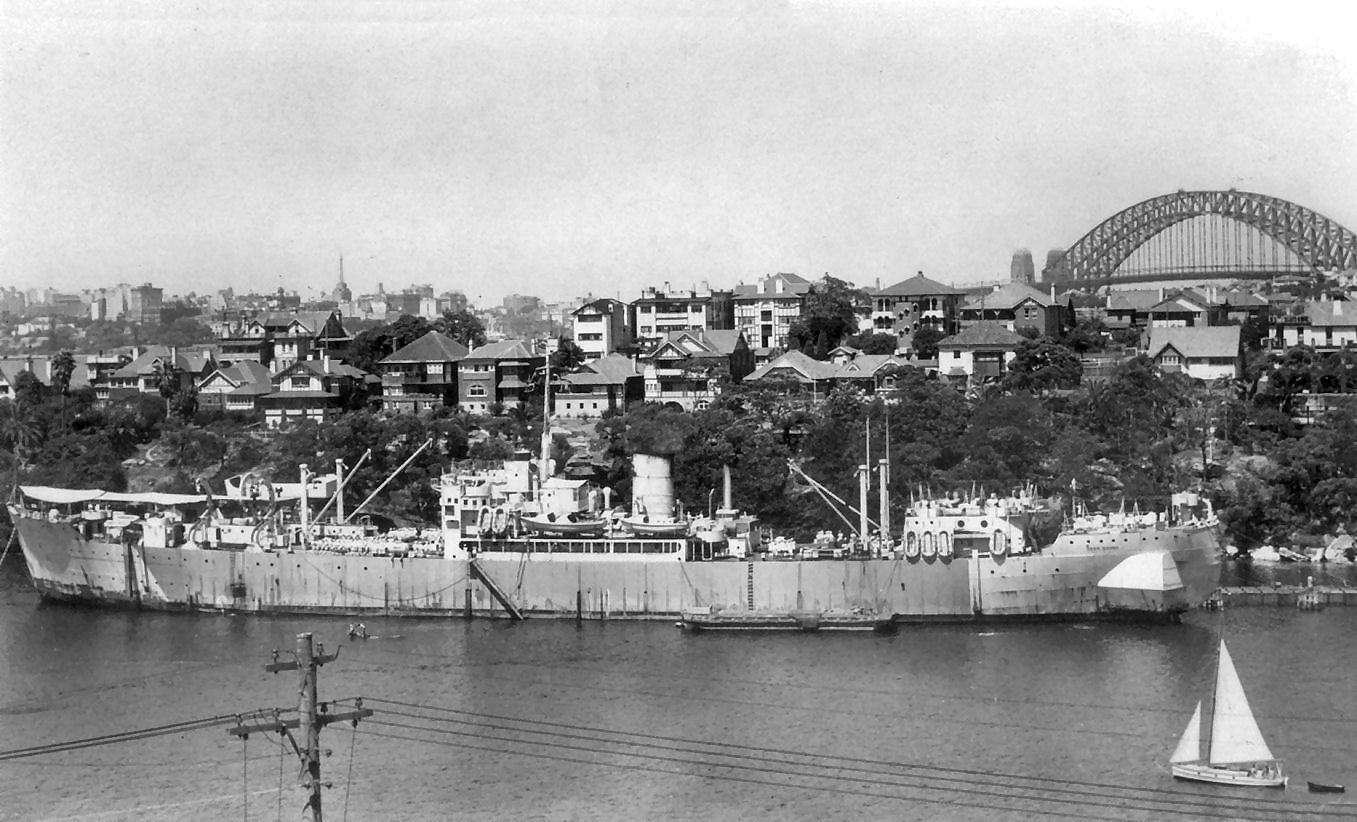Aircraft Component Repair Ship

No badge issued for this vessel
Battle Honours
None
Specifications
Builder:J. L. Thompson & Sons, Sunderland, United Kingdomm
Displacement: 6,924 tons
Length: 468 ft
Beam: 59 ft 8 in
Draught: 26 ft 9 in
Speed: 14 Knots
Crew complement: 450+
Commanding Officers
Captain (acl) (ret) R. H. Johnson, DSC 10 Dec 44
Captain H. S. Allen RD, RNR – Aug 45
Related items
None
Reminiscences
None
Gallery
None
H.M.S. DEER SOUND

H.M.S. DEER SOUND at anchor in Mosman Bay, Sydney C. June 1945
Early history
Originally laid down as the MV PORT QUEBEC at the yard of J.L. Thompson & Sons, Sunderland, for the Port Line, she was requisitioned by the Admiralty on November 25th 1939 and completed in June 1940 as an auxiliary minelayer HMS PORT QUEBEC. She was armed with two 4 inch and four 20mm guns and was capable of carrying 5S0 mines and formed part of the first Mine Laying Squadron between 1940 and 1943 engaged in mine laying operations off the coasts of Holland and Norway.
In 1943 she was purchased from the Port Line by the Admiralty and entered an unknown shipyard to be further converted into an Aircraft Component Repair Ship, one of six such vessels (BEAULY FIRTH1, CUILLIN SOUND, DEER SOUND, HOLM SOUND, MORAY FIRTH and SOLWAY FIRTH) that were planned as Aviation Repair Ships for deployment with the British Pacific Fleet (BPF). The other four ships were 'Moray Firth' class repair ships building in British yards, DEER SOUND was the prototype, a 'one off' conversion which saw her outfitted with general and aeronautical workshops and specialist aircraft instrument and electrical component workshops. On completion she was recommissioned on December 10th 1944 and renamed HMS 'DEER SOUND' after an anchorage near Scapa Flow.
DEER SOUND arrived on the Clyde on January 1st 1945 to embark final stores in preparation for her departure for Australia. Shortly after her arrival at her mooring she was involved in a collision with the Escort Carrier HMS RANEE. The carrier had left her mooring to put to sea for a further week of carrier training but suffered a mechanical breakdown while still in the Firth of Forth which caused the ship to go completely out of control just as she had achieved a speed of some 6 or 7 knots. She inexplicably avoided one ship only to be on a course straight for HMS DEER SOUND. In an attempt to stop the ship the port anchor was let go and this combined with the other attempts at slowing the ship meant that she had lost most of her forward momentum and gently touched the side of DEER SOUND leaving a small dent in her bows.
The embarkation of stores highlighted some shortcomings, especially in the area of air stores; with only seventy-seven per cent of the items listed in her scale of stores supplied before leaving the UK, some 4,500 items short of the full complement of 18,250. Apart from general air stores, the only type of aircraft specific spares received were for Seafire airframes plus Seafire and Firefly propellers. Many deficiencies were met when the ship arrived at Greenock on January 4th, but she was still 2000 items short when she sailed for the Far East four days later.
Allocated to the British Pacific Fleet
On January 8th 1945 DEER SOUND sailed from the Clyde for the Far East for service with the British Pacific Fleet. For the first leg of the voyage she travelled as part of convoy KMF 38 to Gibraltar, from there she took passage to Port Said for the Suez Canal, and then called at Aden before reaching Colombo. Here more spares, tools and equipment were loaded before continuing on to Sydney where she arrived on February 23rd 1945.
While at Sydney DEER SOUND’s maintenance tasking was revised and signals were received ordering her to embark sufficient stores to maintain 250 aircraft for six months. This requirement involved ordering another 15,000 items; however few of these could be obtained before sailing for the Forward Area at the Admiralty Islands as the air stores situation in the Pacific theatre was already stretched to breaking point. On leaving Sydney the ship had a full complement of equipment and tools but still short of essential stores.
From Sydney DEER SOUND proceeded to the intermediate base at Manus, in the Admiralty Islands, arriving there on April 8th before continuing on to San Pedro Bay in the Philippines the following day in company with the Destroyers NAPIER, NEPAL, the Naval Store Carrier BOSPHORUS, and Armament Store Carrier GUDRUN MAERSK. On her arrival at the forward base on April 15th the results of her ongoing store problems became apparent; Captain Merewether C.O. of the Maintenance Carrier UNICORN summed the situation up in a report to Rear Admiral Fleet Train, BPF, 4 May 1945, stating "She is lacking in repair material; hydraulic seals, rivets, but, on arrival at Sydney, she carried arrester hooks, aerofoils, cockpit covers, complete wireless sets and other material, which were of no use to her but were possibly needed elsewhere ... in effect she proved a drain on the fleet. In these circumstances DEER SOUND is being returned to the main base, and it is proposed that she remains there until fully stored- however long that may be."
DEER SOUND arrived back at Manus on June 24th and was anchored at Pityilu Island to work alongside the Maintenance Carrier HMS PIONEER, flying the broad pennant of the Commodore Air Train (COMAT) which had arrived at the Admiralty Islands on June 21st 1945 and established the RN Forward Aircraft Pool ashore at US Naval Air Station Pityilu. They were joined by HMS UNICORN on July 21st. DEER SOUND carried two large motor lighters on her forward deck which were used for conveying plane parts from carriers to the repair ship or to land them ashore.
After the Japanese surrender many of the Fleet Train vessels were dispatched to assist in the re-establishment of the recently liberated British Colonies, DEER SOUND in company with the RAPIDOL, SALVESTOR, SALVICTOR and GREEN RANGER, escorted by HMA Ships GAWLER, LAUNCESTON and TAMWORTH sailed from Manus on August 30th bound for Hong Kong. This small convoy arrived off Hong Kong on September 9th 1945.
Post War
The ship remained in Hong Kong until December before returning to Sydney where preparations were made for her return to the UK. She took on 100 tons of food from the Lord Mayor's Food for Britain appeal1 at Sydney before sailing to Fremantle, arriving there on February 8th 1946. A further 80 tons of food for Britain, consisting of 2300 cases of honey, malted milk, lard, tinned sausages and mince beef loaf were loaded before she departed for Aden and the UK on February 10th.
On her arrival back in the UK she was de-stored and stripped of her work shop equipment before being placed on the disposal list. On December 20th 1947 she was re-purchased by the Port Line for conversion back to her original form and reverted to MV PORT QUEBEC. She arrived at Kaohsiung, Taiwan on 28th June 1968 to be broken up.
Notes:
1. Originally an appeal made by the Lord Mayor of Melbourne in September 1945 to send food to Britain in Mercy Food Shipments. The appeal became nation-wide but was still called the Lord Mayor's Food for Britain appeal.
Last modified: 23 February 2023
Primary information sources
Additional sources:
Jones, B. (2007) [Thesis] Ashore, afloat and airborne: The Logistics of British Naval Airpower, 1914-1945 - Department of War Studies. London, King's College. Accessed online at https://kclpure.kcl.ac.uk/portal/files/2935516/498772.pdf 10 May 2015
The Navy, Magazine of the Navy Legume of Australia Vol 41 issue 2. 1979 Accessed online at http://navyleague.org.au/wp-content/uploads/2011/05/1979-80-Vol_41_Part2.pdf 10 May 2015
H.M.S. Deersound : north to south
The ceremony of crossing the line as carried out on
board H.M.S. "Deer Sound" on the 7th February, 1945. Available online as a
National Library of Australia digitised item
Comments (6)